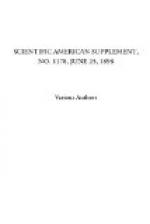The introduction of alternating current for transmission purposes in large cities is probably best exemplified in the station recently erected in Brooklyn, where alternating current is produced and carried to distant points, and then used to operate series arc-light machines run by synchronous motors, the low-tension direct-current network being fed by rotary transformers, and alternating circuits arranged with block converters, and even in some cases separate converters for each individual customer in the scattered districts.
It would be very interesting to go at length into the details of cost in this, the latest development of central station transmission, but time will not permit; nor have I the time at my disposal to go at length into the central station business as developed by the electric street railways now so universally in use, or another phase of the business as exemplified by the large transmission plants, the two greatest examples of which, in this country, are probably those at Niagara Falls, N.Y., and Lachine Rapids, near Montreal. So far as street railways and power transmission are concerned, I would draw your attention to the fact that the same underlying principle of multiple-arc mains and feeders originally conceived by Mr. Edison is as much a necessity in their operation as it is in the electric lighting systems, whether those systems be operated on the old two-wire plan, the three-wire plan or by means of alternating currents.
Passing from a review of central station plants and distribution system naturally bring us to the operating cost and the factors governing profit and loss of the enterprise. In considering this branch of the subject, I will confine my remarks to the business as operated in Chicago by the company with which I am connected.
Our actual maximum last winter came on December 20, our load being approximately 12,000 horse power. A comparison of the figures of maximum capacity and maximum load of last winter shows that we had a margin in capacity over output of about 20 per cent. The load curves shown this evening represent the maximum output of last winter (December 20), an average summer load last year (June 4), and an average spring load of this year (May 2). For our purposes we will assume the maximum capacity of the plant and the maximum load of the system to be identical. The maximum load last winter occurred, as I have stated, on December 20, about 4:30 o’clock in the afternoon, and lasted less than half an hour. It should be borne in mind that the period of maximum load only lasts for from two to three months, and that the investment necessary to take care of that maximum load, has to be carried the whole year. It should not be assumed from this statement that the whole plant as an earning factor is in use 25 per cent. of the year. The fact is that, during the period of maximum load, the total plant is in operation only about 100 hours out of the 8,760 hours of the year; so that you are compelled, in order to get interest on your investment, to earn the interest for the whole of the year in about 11/2 per cent. of that period, on about 50 per cent. of your plant.




